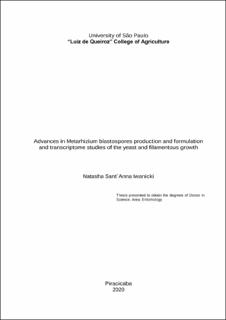| dc.contributor.advisor | Delalibera Junior, Italo | |
| dc.contributor.advisor | Eilenberg, Jørgen | |
| dc.contributor.advisor | De Fine Licht, Henrik H. | |
| dc.contributor.author | Sant´Anna Iwanicki, Natasha | |
| dc.date.accessioned | 2021-02-19T11:28:20Z | |
| dc.date.available | 2021-02-19T11:28:20Z | |
| dc.date.issued | 2020 | |
| dc.identifier.uri | https://hdl.handle.net/11250/2729180 | |
| dc.description.abstract | Biological control of pests is a growing market in the world. It is expected that the use entomopathogenic fungi to control pests will take an important share of this market. Most fungal products in the world are based on aerial conidia produced by solid fermentation using cereal grains. An alternative for aerial conidia is the use of blastospores, yeast-like hydrophilic cells that can be produced in large amounts by liquid fermentation in a short time (<4 days), in a small space and with low hand labor compared to the solid fermentation method. Therefore, the main objectives of the present studies were first to optimize a liquid culture medium for low cost production of Metarhizium blastopores; second: to assess the bioactivity of air-dried blastospores against the cattle-tick Rhipicephalus microplus and the corn-leafhopper Dalbulus maidis; third: to develop an air-dried and spray-dried Metarhizium blastospore formulation with bioactivity against the corn-leafhopper D. maidis; fourth: to improve the shelf-life of the best air-dried and spray-dried formulations stored in refrigerated (± 4°C) and in ambient conditions (28°C) using oxygen and moistures absorbrs or vacuum and fifth: to use comparative genome-wide transcriptome analyses to determine changes in gene expression between the filamentous and blastospore growth phases in vitro to characterize physiological changes and metabolic signatures associated with M. anisopliae and M. rileyi dimorphism. We showed that blastospore production of Metarhizium is isolate- and species-dependent.Glucose-enriched cultures inoculated with pre-cultures improved yields reaching optimal growth for Metarhizium robertsii ESALQ1426 (5.9 × 108 blastospores/mL) within 2 d. We argue that both osmotic pressure, induced by high glucose titers, and isolate selection are critical to produce high yields of blastospores. [...] | en_US |
| dc.language.iso | eng | en_US |
| dc.publisher | University of São Paulo, “Luiz de Queiroz” College of Agriculture | en_US |
| dc.title | Advances in Metarhizium blastospores production and formulation and transcriptome studies of the yeast and filamentous growth | en_US |
| dc.type | Doctoral thesis | en_US |
| dc.subject.nsi | VDP::Landbruks- og Fiskerifag: 900::Landbruksfag: 910::Planteforedling, hagebruk, plantevern, plantepatologi: 911 | en_US |
| dc.source.pagenumber | 248 | en_US |
